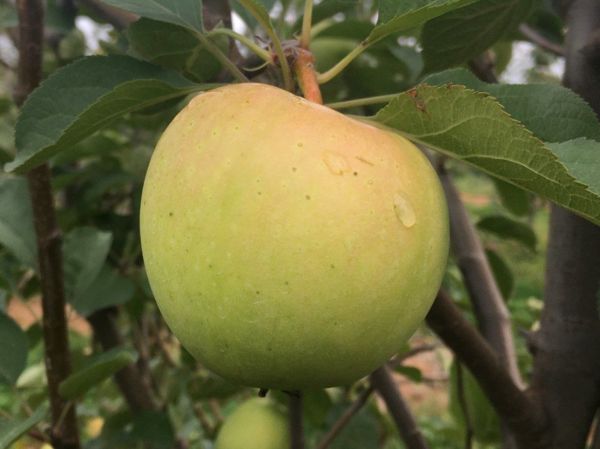An attractive, highly disease-resistant apple, ideal for organic growers.
Harrison Apple on G.890 (Spring 2024)
The most important apple for traditional Newark cider production. Also known as Harrison's Cider, Long Stem, Osborne Apple.
This tree is vigorous and very productive; Tom Burford (Apples of North America) states that a single tree can produce about 100 bushels of apples! It will need thinning to maintain annual bearing and it is tip bearing. It is scab resistant and resistant to rot.
Harrison apples are smallish, round, long-stemmed (hence their alternative name "Long Stem"), and yellow. With a smattering of dark spots and a slightly scruffy exterior, this is not going to win any beauty contests. But when pressed, Harrison yields abundant dark, rich juice that contains an excellent balance of tannin, sugar, and acid, and that can be fermented to a single-variety cider. Along with Campfield and Graniwinkle, this apple was central to Newark cider production before prohibition, and in 1817, Coxe wrote that Harrison commanded the highest price on the New York market as a single-variety cider. (From WSU: Tannin (percent tannic acid): 0.10; Acid (percent malic acid): 0.64; pH: 3.46; SG: 1.061; oBrix 14.6.)
The first Harrison is thought to have been grown by a Mr. Osborne in the early 1700s. These apples were widely grown in Essex County in the early 1800s, but during the 20th century the apple almost disappeared completely, driven almost to the point of extinction by urbanization and lack of interest in cider production. In 1976, the orchardist Paul Gidez happened to stumble across a single tree in Livingston, New Jersey, and in 1989, the pomologist Tom Burford found another Harrison and began to propagate the tree. Thanks to the efforts of these two men Harrison has been resurrected and now enjoys renewed popularity among cider enthusiasts. A more detailed account of this apple's rediscovery can be found in Lost and Found: The Search for the Harrison Apple by Fran McManus.
The Fruit
Fruit Type
Category: Apple
Subcategory:
Heirloom, Cider, Hot-Climate
Fruit Uses & Storage
Uses: cider
Cider classification: sharp
Storage duration: less than one month (approximate, depending on storage conditions)
Fruit Appearance
Skin color: yellow
Flesh color: off-white
Fruit Origins
Parentage: unknown
Origin: New Jersey
Introduced in: 1700s
Introduced by:
The Environment
Calendar & Geography
USDA zones: 5 - 8
Chill hours: Not yet determined
Ripening date: Oct 20 (approximate, in New York State) + 35 days after McIntosh
Tree Height & Spacing
glossary
Rootstock: G.890 Rootstock
Rootstock size class: Half-Standard (60% of Standard)
Tree spacing (natural spread of tree): 18'
Good for wildlife planting? N
Diseases & Pests
glossary
Apple Scab: Very Resistant
Fireblight: Very Resistant
Cedar-Apple Rust: Very Resistant
Powdery Mildew: Resistant
Pollination
Pollination Factors
glossary
Bloom group: 3
Is it self-fertile? N
Is it fertile? Y
Ploidy: Diploid
Rootstock size class:
Half-Standard (60% of Standard)
Pollination Partners
This table shows the first few results from a full search for pollenizers of Harrison Apple on G.890. Please see our Pollenizer Search to run other queries and read how the application uses various factors. Also read more about fruit tree pollination.
See all pollination matches for Harrison Apple on G.890
Featured Products
A few things we're loving right now...
A full-flavored, freestone white peach.
One of America's oldest apples, good for storage, baking, and cider.
A widely-grown, large, yellow-fleshed nectarine.




















